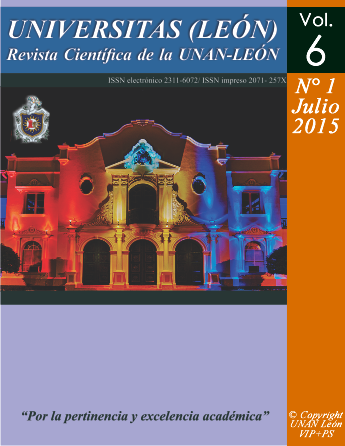Clinical, epidemiological and laboratory study of vulvovaginitis associated with yeasts in women older than 15 years of the city of Leon, Nicaragua.
DOI:
https://doi.org/10.5377/universitas.v6i1.13716Keywords:
Candida, Saccharomyces cerevisiae, Candidiasis vulvovaginal, EpidemiologyAbstract
Vaginal infections occur in 75% of women. This study aims to describe the clinical, epidemiological and laboratory characteristics of vulvovaginitis associated with yeast in women over 15 years of age. A total of 391 samples of vaginal exudates were cultured and analyzed with the Rapid Yeast Plus System (oxoid) method. A frequency of yeasts of 27% was obtained, being more frequent in women of 15 to 30 years of age (34%, p = 0.002), with level of education of average technician or superior (38%), marital status "accompanied" (30%) and with other occupations (35%). The main predisposing factors identified were: pregnancy (36%), diabetes (54%), use of contraceptives (43%), use of nylon or tight underwear (31%) and having presented 2-4 episodes of vaginitis in the last year (53%). The clinical manifestations presented were: itching (55%), burning and burning sensation (48%) and irritation (39%), with a whitish color flow (97%), homogeneous appearance (77%) and moderate amount ( 39%). We identified: C.albicans (70%), C.glabrata (19%), S.cerevisiae (4%), C. parapsilosis (3%), C. krusei (2%), C. tropicalis (1%) and T. asahii (1%). C. glabrata was more common in women older than 61 years and the other species in women between 15-45 years of age. C. krusei, S. cerevisiae, C. glabrata and C. albicans were isolated from patients with recurrent vaginitis. It is recommended to carry out the antifungal resistance profile.
Downloads
References
Rein M. Vulvovaginitis y cervicitis. In: Panamericana E, editor. Enfermedades Infecciosas Principios y Práctica. 4 ed. Bue- nos Aires1997.
Arenas R. Candidosis. In: Nueva Editorial Interamericana SA, editor. Micología Médica Ilustrada. 1 ed. Mexico1993. p. 223-34.
Llovera VS, Perurena M. Identificación de levaduras de exudados vaginales: características clínicas asociadas a la candidia sis. Revista Cubana de Medicina Tropical. 2004;56:21-5.
Sanz F, Pazos C. Infección vaginal causada por Saccharomyces cerevisiae: aspectos clínicos. Pediatria. 2002;61(662):291-3.
Pereira DN, Nader SS, Nader P, Martins PG, Furlan SP, Hentges CR. Disseminated Trichosporon spp infection in preterm newborns: a case report. Jornal de pediatria. 2009 Sep-Oct;85(5):459-61. https://doi.org/10.2223/JPED.1923
Sobel J CW. Update on treatment of vulvovaginal candidiasis. Rev Iberoam Micol 1996;13(44):6.
Ozer E, Unlu M, Ersen A, Gulekli B. Intrauterine fetal loss associated with Candida glabrata chorioamnionitis: report of two cases. Turk patoloji dergisi. 2013;29(1):77-9. https://doi.org/10.5146/tjpath.2013.01154
Lewis RE, Viale P, Kontoyiannis DP. The potential impact of antifungal drug resistance mechanisms on the host immune response to Candida. Virulence. 2012 Jul 1;3(4):368-76. https://doi.org/10.4161/viru.20746
Darce Bello M, Gonzalez A, Barnabe C, Larrouy G. First characterization of Candida albicans by random amplified poly morphic DNA method in Nicaragua and comparison of the diagnosis methods for vaginal candidiasis in Nicaraguan women. Memorias do Instituto Oswaldo Cruz. 2002 Oct;97(7):985-9. https://doi.org/10.1590/S0074-02762002000700010
Desarrollo INdIy. León en Cifras, Nicaragua. 2008.
Mendoza M, Gonzalez I, Bellorin EJ, Salazar W, Mendoza L, Zambrano EA, et al. [Isolation, identification and serotyping of yeasts obtained from the vaginal fluid in patients with clinical vaginitis]. Investigacion clinica. 1999 Mar;40(1):25- 36.
Mascarenhas RE, Machado MS, Costa e Silva BF, Pimentel RF, Ferreira TT, Leoni FM, et al. Prevalence and risk factors for bacterial vaginosis and other vulvovaginitis in a population of sexually active adolescents from Salvador, Bahia, Brazil. Infectious diseases in obstetrics and gynecology. 2012;2012:378640 https://doi.org/10.1155/2012/378640
Tchelougou D, Karou DS, Kpotsra A, Balaka A, Assih M, Bamoke M, et al. [Vaginal infections in pregnant women at the Regional Hospital of Sokode (Togo) in 2010 and 2011]. Medecine et sante tropicales. 2013 Jan-Mar;23(1):49-54.
https://doi.org/10.1684/mst.2013.0142
Foxman B. The epidemiology of vulvovaginal candidiasis: risk factors. American journal of public health. 1990 Mar;80(3):329-31.
https://doi.org/10.2105/AJPH.80.3.329
Reed BD. Risk factors for Candida vulvovaginitis. Obstetrical & gynecological survey. 1992 Aug;47(8):551-60.
https://doi.org/10.1097/00006254-199208000-00015
Ryley JF. Pathogenicity of Candida albicans with particular reference to the vagina. Journal of medical and veterinary my cology : bi-monthly publication of the International Society for Human and Animal Mycology. 1986 Feb;24(1):5- 22.
https://doi.org/10.1080/02681218680000021
Powell BL FC, Drutz DJ. Identification of a 17p-estradiol binding protein in Candida albicans and Candida (Torulopsis) glabrata. Mycology.8:304-13. https://doi.org/10.1016/0147-5975(84)90054-9
Ahmad A, Khan AU. Prevalence of Candida species and potential risk factors for vulvovaginal candidiasis in Aligarh, India. European journal of obstetrics, gynecology, and reproductive biology. 2009 May;144(1):68-71.
https://doi.org/10.1016/j.ejogrb.2008.12.020
Leli C, Mencacci A, Meucci M, Bietolini C, Vitali M, Farinelli S, et al. Association of pregnancy and Candida vaginal colo-nization in women with or without symptoms of vulvovaginitis. Minerva ginecologica. 2013 Jun;65(3):303-9.
Filippidi A, Galanakis E, Maraki S, Galani I, Drogari-Apiranthitou M, Kalmanti M, et al. The effect of maternal flora on Candida colonisation in the neonate. Mycoses. 2013 Jun 12.
https://doi.org/10.1111/myc.12100
Julia María Sánchez Schmidta AVV, Antonia González. Manifestaciones cutáneas en las candidiasis perinatales. Dermatología España. 2005;20(9):450 - 6. https://doi.org/10.1016/S0213-9251(05)72324-8
Atabek ME, Akyurek N, Eklioglu BS. Frequency of Vaginal Candida Colonization and Relationship between Metabolic Pa-rameters in Children with Type 1 Diabetes Mellitus. Journal of pediatric and adolescent gynecology. 2013 Oct;26(5):257-60.
https://doi.org/10.1016/j.jpag.2013.03.016
Baris, II, Keles AN. [A review on the impact of IUD in cervical cytology: Mardin Region Data]. Turk patoloji dergisi. 2013;29(1):51-7.
https://doi.org/10.5146/tjpath.2013.01148
Caliskan S, Keceli Ozcan S, Cinar S, Corakci A, Caliskan E. [In vitro biofilm formation and relationship with antifungal resistance of Candida spp. isolated from vaginal and intrauterine device string samples of women with vaginal complaints]. Mikrobiyoloji bulteni. 2011 Oct;45(4):697-706.
Paiva LC, Donatti L, Patussi EV, Svizdinski TI, Lopes-Consolaro ME. Scanning electron and confocal scanning laser mi croscopy imaging of the ultrastructure and viability of vaginal Candida albicans and non- albicans species adhered to an intrauterine contraceptive device. Microscopy and microanalysis : the official journal of Microscopy Society of America, Microbeam Analysis Society, Microscopical Society of Canada. 2010 Oct;16(5):537-49. https://doi.org/10.1017/S1431927610093773
Mahmoudi Rad M, Zafarghandi A, Amel Zabihi M, Tavallaee M, Mirdamadi Y. Identification of Candida species associated with vulvovaginal candidiasis by multiplex PCR. Infectious diseases in obstetrics and gynecology. 2012;2012:872169.
https://doi.org/10.1155/2012/872169
Paola Janeth Villarroel Rodríguez ACSCR. Identificación de especies de levaduras del género Cándida aislados de exudados vaginales de pacientes en el Hospital Materno Germán Urquídi. Gaceta médica Boliviana. 2011;32(4).
Cararach Tur M, Comino Delgado R, Davi Armengol E, Marimon García E, Martínez Escoriza JC, Palacios Gil-Antuñano S, et al. La vulvovaginitis candidiásica recurrente. Progresos de Obstetricia y Ginecologia. 2013;56(2):108-16. https://doi.org/10.1016/j.pog.2012.05.014
Correa Pdos R, David PR, Peres NP, da Cunha KC, de Almeida MT. [Phenotypic characterization of yeasts isolated from the vaginal mucosa of adult women]. Revista brasileira de ginecologia e obstetricia : revista da Federacao Brasileira das Sociedades de Ginecologia e Obstetricia. 2009 Apr;31(4):177-81. https://doi.org/10.1590/S0100-72032009000400004
Sugita T, Ichikawa T, Matsukura M, Sueda M, Takashima M, Ikeda R, et al. Genetic diversity and biochemical characteris- tics of Trichosporon asahii isolated from clinical specimens, houses of patients with summer-type-hypersensitivity pneumonitis, and environmental materials. Journal of clinical microbiology. 2001 Jul;39(7):2405-11.
https://doi.org/10.1128/JCM.39.7.2405-2411.2001
Posteraro B, Sanguinetti M, D'Amore G, Masucci L, Morace G, Fadda G. Molecular and epidemiological characterization of vaginal Saccharomyces cerevisiae isolates. Journal of clinical microbiology. 1999 Jul;37(7):2230-5.
https://doi.org/10.1128/JCM.37.7.2230-2235.1999
McCullough MJ, Clemons KV, Farina C, McCusker JH, Stevens DA. Epidemiological investigation of vaginal Saccha romyces cerevisiae isolates by a genotypic method. Journal of clinical microbiology. 1998 Feb;36(2):557-62.
https://doi.org/10.1128/JCM.36.2.557-562.1998
Nyirjesy P, Vazquez JA, Ufberg DD, Sobel JD, Boikov DA, Buckley HR. Saccharomyces cerevisiae vaginitis: transmission from yeast used in baking. Obstetrics and gynecology. 1995 Sep;86(3):326-9. https://doi.org/10.1016/0029-7844(95)00174-P
Trama JP, Adelson ME, Raphaelli I, Stemmer SM, Mordechai E. Detection of Candida species in vaginal samples in a cli- nical laboratory setting. Infectious diseases in obstetrics and gynecology. 2005 Jun;13(2):63-7. https://doi.org/10.1080/10647440400025629
Vermitsky JP, Self MJ, Chadwick SG, Trama JP, Adelson ME, Mordechai E, et al. Survey of vaginal-flora Candida species isolates from women of different age groups by use of species-specific PCR detection. Journal of clinical microbio- logy. 2008 Apr;46(4):1501-3.
Downloads
Published
How to Cite
Issue
Section
License
Copyright (c) 2015 UNIVERSITAS (LEÓN): SCIENTIFIC JOURNAL OF THE UNAN-LEÓN

This work is licensed under a Creative Commons Attribution-NonCommercial-ShareAlike 4.0 International License.
Copyright © 2025 Universitas (León), Revista Cientifíca de la UNAN-León. Academic Direction. Research Department. Publication and Scientific Event Unit.










